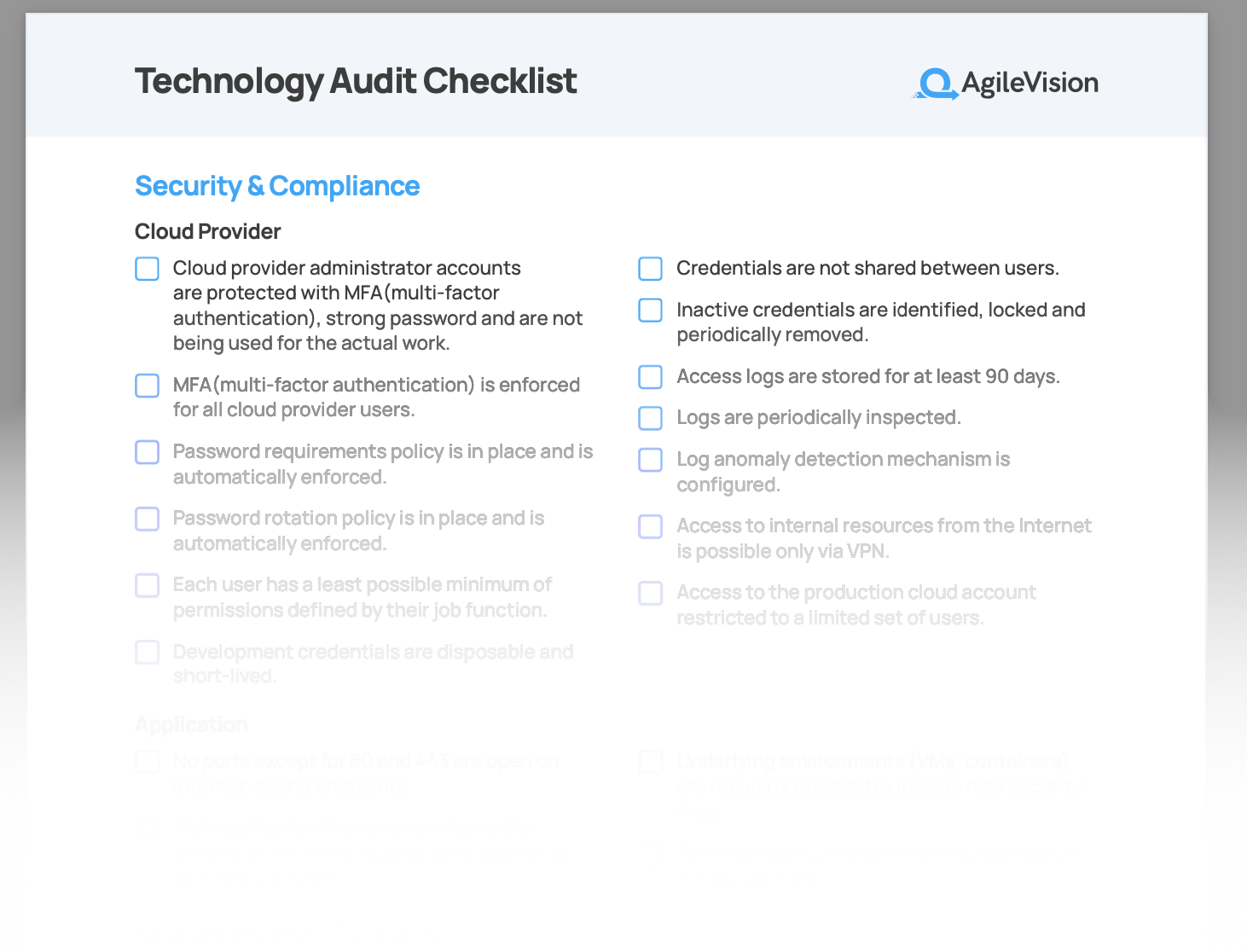What is a technology audit and why it's important
Volodymyr Rudyi

Once the business decides to innovate, a new journey of experiments and hypothesis checks begin.
Small and medium business owners know how it can be difficult to handle everything at once with a limited team size. On the other hand, reduced amount of bureaucracy and flat structure gives advantages like agility and speed of implementation.
After the market fit is found, stabilization phase begins with a goal to make every aspect of business as efficient as it's possible, ensure perfect customer experience and tie up loose ends. The big catch is the technical debt hidden deeply inside cloud infrastructure and software architecture, which is usually left as is waiting to disrupt the normal operation of the product.
According to McKinsey, companies pay whopping 40 percent "tech debt tax" due to delayed digital transformation decisions. It's acceptable of course in some situations, when such decision is a conscious choice dictated by business needs, circumstances or regulations. Unfortunately, in many cases business owners and startup founders even don't realize how much they are paying to service their technical debt.
To reveal such hidden technical debt, a detailed review of technology aspects of your business is required. When you are working on a software product for a while, you may start asking yourself various questions:
- Are we following all the necessary best practices?
- Is our architecture good scalable and secure?
- Are we missing security vulnerabilities?
- Do we really have all the software assets developed by third-party vendors?
Additionally, technical debt can have it's internal "guardians" who may want to maintain the status quo for various reasons.
To mitigate risks described above and ensure efficient operations, proper security and optimal usage of cloud services, an external technology audit is one of the best options.
Main components of technology audit
Depending on customer expectations, requirements, industry, type and depth, areas covered during the technology audit process may vary. In general, any technology audit, independent from the depth, should cover the following areas to be beneficial for the business owner:
- Infrastructure review - underlying infrastructure review to validate it's scalability, security and cost efficiency.
- Architecture review - review of software product to ensure the architecture is scalable, secure and ready for next growth stages of the business.
- Process review - review of applied software development practices to ensure the developed product is stable and can be maintained. This includes code quality review, project management practices analysis, usage of industry best practices like DevOps and CI/CD.
- Software Supply Chain review - review of used third-party dependencies and tools to prevent upstream and dependency attacks on your products.
- Software asset management review - review of used digital assets in your product and verification all of these assets belong to you and you actually have those. This helps to prevent situations when a third-party vendor disappears and takes all the code of your product.
Each of these items can be a subject to a separate, in-depth specialty audit on it's own. For example, in-depth security audit. Besides it, depending on the industry, compliance audits may be conducted like SOC II. It makes sense to start with a general audit to reveal the most problematic areas and then to decide whether a deeper inspection is required for each of the components.
When should a business owner consider a technology audit?
There are different cases, when technology audit may be required or highly recommended to ensure smooth operation of business and great end-user experience:
- After Significant Growth: After a period of rapid growth or scaling, to ensure the technology infrastructure can support the expanded business operations effectively.
- Data breaches and severe downtime incidents: It makes sense to perform an external technological audit after major incidents to identify vulnerabilities and prevent future fails.
- M&A: Before such events like mergers, acquisitions, or creating new business partnerships, a technology audit serves as a baseline to evaluate the business.
- Frequent Performance Issues: In a case if your software product has consistent performance and stability issues, this may be a powerful indictor to involve an external audit and get a fresh look on your product internals.
Additionally, there is a recommendation to have periodic technology audits for three reasons:
- Continuous Improvement: Periodic review to ensure the technology aligns with business goals.
- Strategic Planning: As part of strategic planning, to support business objectives and growth plans with corresponding infrastructure and software in place.
- Certifications, and regulations: To stay compliant with certain regulations or meet certification requirements of certain bodies, technological audit may be required.
Benefits of the technology audit
One of the reasons business owners can be hesitant in doing a technology audit for the first time is unclear ROI(Return on Investment). To better understand benefits of the technology audit, it's crucial to know results of audit can be both quantifiable in strict financial terms and also have indirect influence on various aspects of the business like efficiency and security.
Let's look in detail on benefits a technology audit brings to your business. Typically, businesses see a return in:
- Cost savings: technology audit may uncover unused cloud infrastructure pieces, not needed tools licenses and subscriptions. Such improvements result in direct cost savings.
- Improved customer experience: Identifying performance bottlenecks and friction areas helps to fix issues that may affect customer experience.
- Security: Identifying and fixing security issues before those are exploited by malicious parties can prevent substantial losses.
- Risk mitigation and compliance: Technology audits help in staying compliant with laws, regulations and certification requirements important for your business.
- Beating the competition: Often technical debt and inefficiency appears when you hear "We've Always Done It This Way" too often. A fresh look on your product may help you to make informed decisions about IT investments and strategy on time and gain competitive advantage.
- Scalability: External audit can help you better understand whether you business is ready to meet future business needs and what should be done to be ready for the next step.
In other words, to evaluate the ROI of the technology audit properly, you need to take into account both direct and indirect outcomes.
To better understand wherther you need an information technology audit and prepare to one, we created this free checklist.

IT Audit Checklist
Simple way to determine if you need an information technology audit and identify potential issues in your IT infrastructure.
How to get most of the technology audit?
You need to remember, audit itself is not about fixing problems, but identifying such problems and preparing a roadmap to resolve found issues. To get the most of the audit, a certain mindset is required along with openness to change. Here are some best practices and steps to maximize benefits of the technology audit.
Define clear goals
Before doing any kind of audit, it's an absolute requirement to clearly define your goals, desired outcomes and areas you want to focus on. For example, you may want to enhance the system security, improve performance, validate compliance or prepare for future growth.
Define scope
While it's tempting to audit everything, it may be time-consuming, expensive and absolutely unnecessary. Clearly define which components, processes and areas of your product must be reviewed.
Choose the right partner
Ensure your auditor has relevant expertise in your industry and technology stack. Check their reputation and don't hesitate to ask about testimonials.
Prepare your team
External audits, especially for the first time, can be a stress for the internal team. This can result in internal resistance and additional friction. It's very important to communicate with your team and stress out external auditing team is here to help with the joint effort to grow the product and the business and not to do any kind of blaming and finger-pointing. Transparency and collaboration with the auditor is the key factor to a successful audit.
Act on the findings
Any audit can become useless, if all findings are ignored. Carefully review all findings and recommendations. Prioritize every item based on projected impact, feasibility and your strategic plans. Set up metrics and monitoring in place to understand impact of each change and whether it's delivering planned/desired results.
Use the Continuous Improvement approach
Instead of considering audit a one-time event, add it as a regular activity to your workflow with a reasonable interval.
Leverage external expertise
Don't hesitate to seek external advice or consultation when implementing complex or critical recommendations. When applicable, use such consultation to train your in-house team and level-up internal processes and practices.
How AgileVision can help?
Over the past several years, AgileVision has conducted software audits for many businesses and helped them cut down cloud hosting costs, improve the product’s scalability, and identify security issues.


